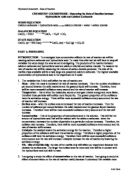The Reaction Between Calcium Carbonate and Hydrochloric Acid
Planning
Aim
I intend to find out the effects of changing the concentration of hydrochloric acid and the surface area of calcium carbonate on the rate of reaction in the reaction below:
Calcium + Hydrochloric Calcium + Water + Carbon Dioxide
Carbonate Acid Chloride
CaCO3 + 2HCL CaCl2 + H2O + CO2
Scientific Knowledge
> Chemical reactions can take place at different speeds.
> A reaction which is over in a fraction of a second is a very fast reaction i.e. it has a high rate of reaction. As the time taken for the reaction to be completed increases, the rate of reaction decreases. That is:
Rate of Reaction ? 1/Time
> Increasing the concentration of reactants increases the rate of reaction.
> Increasing the pressure of gases increases the rate of reaction.
> In both cases, there are more collisions between particles which could lead to more successful outcomes, and hence a faster reaction.
> Increasing the temperature increases the rate of reaction.
> Increasing the temperature increases the average speed of particles and kinetic energy. Faster moving particles result in more collisions. More collisions are successful because the particles pass the activation energy necessary for the reaction.
For a reaction to occur:
Reactant particles must collide.
Collisions must have the minimum activation energy.
The Rate of Reaction is increased by:
Concentration/Pressure
Surface Area
Catalyst
Temperature
Concentration/Pressure
More particles in the same space.
?More collisions
?More successful collisions and a faster reaction.
Fig.1.a low conc. Fig.1.b high conc.
As you can see in figure 1.a there are much less atoms than in figure 2. More atoms in figure 1.b so it is much more likely that atoms may collide. If atoms collide more often there is a greater chance of successful collisions, which means a faster rate of reaction.
Surface Area
More surface for collisions to occur
?more collisions
?more successful collisions and a faster reaction.
A higher surface area means that there is more surface for the collisions to occur. Again this means that there is a greater chance of successful collisions, which means a faster rate of reaction.
Catalyst
Reduces the minimum activation energy
?More collisions are successful and a faster reaction.
Temperature
Works in two ways
. Particles move faster
?More collisions
?More successful collisions and a faster reaction
2. Particles move with more energy
?More successful collisions and a faster reaction.
Planning
Aim
I intend to find out the effects of changing the concentration of hydrochloric acid and the surface area of calcium carbonate on the rate of reaction in the reaction below:
Calcium + Hydrochloric Calcium + Water + Carbon Dioxide
Carbonate Acid Chloride
CaCO3 + 2HCL CaCl2 + H2O + CO2
Scientific Knowledge
> Chemical reactions can take place at different speeds.
> A reaction which is over in a fraction of a second is a very fast reaction i.e. it has a high rate of reaction. As the time taken for the reaction to be completed increases, the rate of reaction decreases. That is:
Rate of Reaction ? 1/Time
> Increasing the concentration of reactants increases the rate of reaction.
> Increasing the pressure of gases increases the rate of reaction.
> In both cases, there are more collisions between particles which could lead to more successful outcomes, and hence a faster reaction.
> Increasing the temperature increases the rate of reaction.
> Increasing the temperature increases the average speed of particles and kinetic energy. Faster moving particles result in more collisions. More collisions are successful because the particles pass the activation energy necessary for the reaction.
For a reaction to occur:
Reactant particles must collide.
Collisions must have the minimum activation energy.
The Rate of Reaction is increased by:
Concentration/Pressure
Surface Area
Catalyst
Temperature
Concentration/Pressure
More particles in the same space.
?More collisions
?More successful collisions and a faster reaction.
Fig.1.a low conc. Fig.1.b high conc.
As you can see in figure 1.a there are much less atoms than in figure 2. More atoms in figure 1.b so it is much more likely that atoms may collide. If atoms collide more often there is a greater chance of successful collisions, which means a faster rate of reaction.
Surface Area
More surface for collisions to occur
?more collisions
?more successful collisions and a faster reaction.
A higher surface area means that there is more surface for the collisions to occur. Again this means that there is a greater chance of successful collisions, which means a faster rate of reaction.
Catalyst
Reduces the minimum activation energy
?More collisions are successful and a faster reaction.
Temperature
Works in two ways
. Particles move faster
?More collisions
?More successful collisions and a faster reaction
2. Particles move with more energy
?More successful collisions and a faster reaction.






